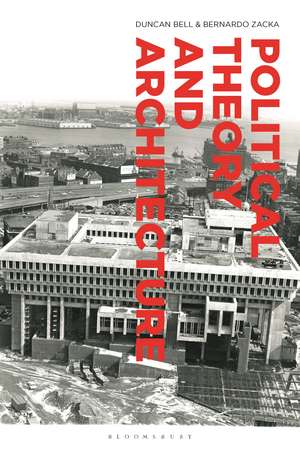Political Theory and Architecture
Editat de Duncan Bell, Bernardo Zackaen Limba Engleză Paperback – 16 iun 2021
| Toate formatele și edițiile | Preț | Express |
|---|---|---|
| Paperback (1) | 181.32 lei 3-5 săpt. | |
| Bloomsbury Publishing – 16 iun 2021 | 181.32 lei 3-5 săpt. | |
| Hardback (1) | 600.15 lei 6-8 săpt. | |
| Bloomsbury Publishing – 19 feb 2020 | 600.15 lei 6-8 săpt. |
Preț: 181.32 lei
Preț vechi: 233.87 lei
-22% Nou
Puncte Express: 272
Preț estimativ în valută:
34.70€ • 36.02$ • 28.93£
34.70€ • 36.02$ • 28.93£
Carte disponibilă
Livrare economică 04-18 martie
Preluare comenzi: 021 569.72.76
Specificații
ISBN-13: 9781350250826
ISBN-10: 1350250821
Pagini: 328
Dimensiuni: 156 x 234 mm
Greutate: 0.48 kg
Editura: Bloomsbury Publishing
Colecția Bloomsbury Academic
Locul publicării:London, United Kingdom
ISBN-10: 1350250821
Pagini: 328
Dimensiuni: 156 x 234 mm
Greutate: 0.48 kg
Editura: Bloomsbury Publishing
Colecția Bloomsbury Academic
Locul publicării:London, United Kingdom
Caracteristici
The interaction between architecture and political theory is of growing concern to scholars globally, as populations become increasingly concentrated in urban areas
Notă biografică
Duncan Bell is Professor of Political Thought and International Relations at the University of Cambridge, UK.Bernardo Zacka is Assistant Professor of Political Science at the Massachusetts Institute of Technology, USA.
Cuprins
Introduction, Duncan Bell (University of Cambridge, UK) and Bernardo Zacka (Massachusetts Institute of Technology, USA) Part One: Architecture and Political Regimes1. What (If Anything) is 'Democratic Architecture'? Jan-Werner Müller (Princeton University, USA)2. Fortification and Democracy in the Ancient Greek World, Josiah Ober (Stanford University, USA) and Barry Weingast (Stanford University, USA)3. Plato's Magnesia and Costa's Brasilia, Gabor Betegh (University of Cambridge, UK) Part Two: Architecture as Constitutive of Political Space4. What's in a Balcony? The In-Between as Public Good, Bernardo Zacka (Massachusetts Institute of Technology, USA)5. Durability and Citizenship: Towards an Arendtian Political Philosophy of Architecture, Ronald Beiner (University of Toronto, Canada)6. The Soft Power of Neighbors: Proximity, Scale, and Responses to Violence, Nancy Rosenblum (Harvard University, USA) Part Three: Architecture as Infrastructure: Governmentality and Political Economy7. Scripting the City: J. G. Ballard Among the Architects, Duncan Bell (University of Cambridge, UK)8. Architecture as Government, Ali Aslam (Mount Holyoke College, USA)9. Making Superstar Cities Work: Jane Jacobs in Toronto, Margaret Kohn (University of Toronto, USA)10. Whose Right to the City? Lessons from the Territorial Rights Debate, Benjamin Hofmann (Princeton University, USA) Part Four: The Political Agency of Architecture11. Can Architecture Really Do Nothing? Lefebvre, Bloch, and Jameson on Utopia, Nathaniel Coleman (Newcastle University, UK)12. The Architecture of Political Renewal, Mihaela Mihai (University of Edinburgh, UK)13. The Modesty of Architecture, Randall Lindstrom (University of Tasmania, Australia) and Jeff Malpas (University of Tasmania, Australia) 14. Architecture, Materiality and Politics: Sensations, Symbols, Situations and Decors, Antoine Picon (Harvard Graduate School of Design, USA) Epilogue: Top-Down / Bottom-Up: Co-Producing the City, Fonna Forman (UC San Diego, USA) Index
Recenzii
This marvelous collection, teeming with imagination and critical intelligence, shows how exciting it can be when political theorists go beyond using architectural metaphors to think literally about the built environment-from the aesthetics of individual architectural elements, to the political economy of whole cities, to the political concepts embedded in architectural practice (and beyond). Inspiring and essential.
Political Theory and Architecture is a lively array of essays that establish new terrain for political theorists to explore. The authors use remarkably diverse methodologies to explore how the buildings we occupy reflect, sustain and change our politics. And while they use the tools of political theory to help us understand architecture, just as surely, the volume enriches our conception of politics through rigorous examination of architecture.
How should we think about the relationship of politics and architecture? In what ways does the built environment within which we act and interact shape our social and political relationships? Can distinct architectural styles be expressive of particular political values or types of government or forms of community? Does architectural practice act as an agent that enables oppression or emancipation? In addressing such questions, the diverse contributors to this excellent collection construct new sites from which to engage the relationship of architecture and politics, offering new vistas on a topic that has been neglected for too long.
Political Theory and Architecture is a lively array of essays that establish new terrain for political theorists to explore. The authors use remarkably diverse methodologies to explore how the buildings we occupy reflect, sustain and change our politics. And while they use the tools of political theory to help us understand architecture, just as surely, the volume enriches our conception of politics through rigorous examination of architecture.
How should we think about the relationship of politics and architecture? In what ways does the built environment within which we act and interact shape our social and political relationships? Can distinct architectural styles be expressive of particular political values or types of government or forms of community? Does architectural practice act as an agent that enables oppression or emancipation? In addressing such questions, the diverse contributors to this excellent collection construct new sites from which to engage the relationship of architecture and politics, offering new vistas on a topic that has been neglected for too long.
